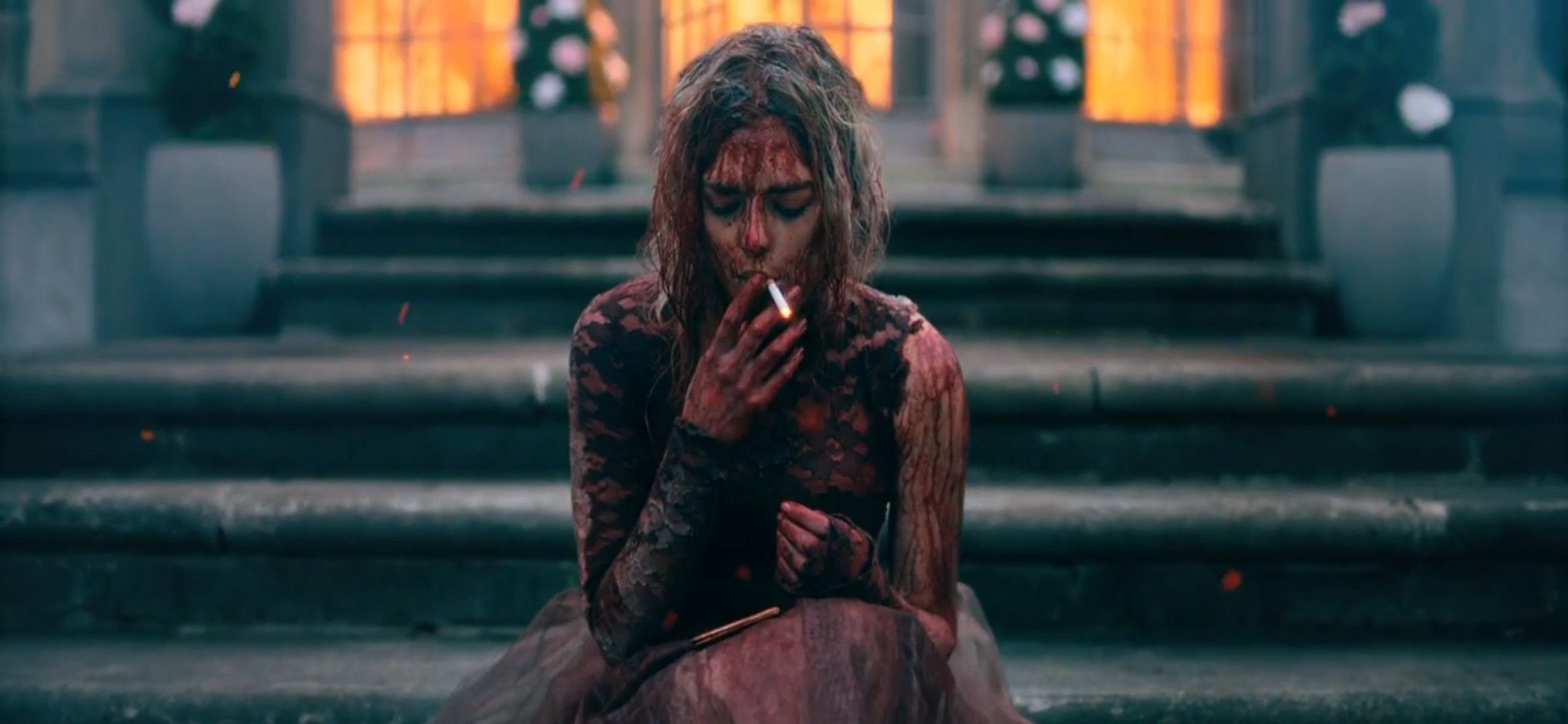[Editorial] The Blood Soaked Woman – An Observation and Reading of a Horror Trope
It is your wedding day, but your new in-laws want to kill you to satisfy a curse, or you and your friends have gone spelunking in an unknown cave system which just so happens to be the home of some mutated humanoid creatures or perhaps you have just been crowned prom queen when you were under the impression everyone at school thought you a freak. How do you imagine you would look at the end of these stories? Spoiler alert - you will be drenched in blood.
It’s an image we have seen over and over again; a woman, head to toe saturated in blood, the whites of her eyes piercing through the red – she is transformed. We have seen examples of this trope in horror for decades, from the iconic pig’s blood scene in Carrie (1976), Sarah (Shauna Macdonald) emerging from the blood pool in The Descent (2005) and more recently Grace (Samara Weaving) in Ready or Not (2019) sitting on the steps of her in-law’s house covered in their blood after they blew up around her.
Horror loves an end with the final girl and blood splattered across their face. Think Sydney Prescott (Neve Campbell) at the end of Scream (1996) and Erin (Sharni Vinson) in You’re Next (2011) . Final girls and blood are soul mates in the horror storytelling arsenal. When a film turns up the blood dial and soaks their female characters head to toe this allows them to be figuratively reborn from the original naïve and innocent female characters into their new role as hardened ‘bad ass’.
In Ready or Not and Carrie our female protagonists’ innocence is compounded with their feminine and light coloured dresses which highlight the transition to the red coating the women now wear. Sarah in The Descent comes from another place of innocence as she is dealing with the grief of losing her family. It is important to note, contrary to the usual final girl’s blood spattered face image - where their blood might come from self defence - in these examples the blood drenching is not caused by their own hands but by external forces. I interpret the blood drenching to be what saves these women, either literally by breaking the fall of Sarah in The Descent and more recently Rachel (Ashley Tisdale) in The House of Ashes game allowing both women to hide in plain sight in the darkness of their environments, or it can save them by unlocking their once hidden potential. Where these female characters may have been accused of being passive in the past, they are thrust into a situation where they need to be cunning and aggressive to survive.
A person’s first period is often seen as the milestone of entering the beginnings of adulthood and a coming of age. The women portrayed in these films are coming of age in the most horrific sense of the term, they are becoming hardened to the events around them and are ready to fight back against the ‘evil’. A monthly sprinkle for some – a lot more for others - signals the start of a new menstrual cycle. People who might be more connected to their bodies than me, take this opportunity, the monthly shedding of old and the regrowth of new to reflect in their personal endeavours. And with these characters, the drenching of blood signals their own growth into the women we see at the end of the films. Carrie leans into this interpretation further with the infamous ‘plug it up’ scene where she gets her first period in the communal gym shower and does not know what to do while her peers mock her naivety. Her inaugural period awakens telekinetic powers and her subsequent blood dunking at the hands of her bullies allows her full access to the power.
HAVE YOU LISTEN TO OUR GHOULS PODCAST YET ?
Arguably people who experience periods are more accustomed to dealing with blood than others as each month many of us are faced with the sight of blood and we remain unfazed. We see this comfort in blood with these characters as when they experience their drenching, they are in no rush to wash it off – they wear it for the rest of the film, as a badge of honour, a bat signal to their antagonists that they have transitioned into survivor mode. Compare that with some reactions to periods (mainly from cis-men) in society. Unfortunately there are far too many Reddit posts of men asking the internet whether a woman accidentally bleeding on the sheets is grounds for a break up and the fact that tampon and sanitary towel adverts use blue liquid to show how absorbent the product is rather than red incase the audience is offended by the sight of something remotely looking like blood. Revenge (2017) was praised as a modern rape revenge film through the female gaze. Protagonist Jen has been sexually assaulted and left for dead via impalement on a tree. In her final confrontation with her former boyfriend Richard - the two start a chase around the house, him covered in blood while leaving a trail for Jen to follow. In this example both man and woman are covered in blood, but Jen is more accustomed to dealing with it as Richard, unsteady in his new role as the bloodied victim, slips and slides - ultimately leading to his death at her hands.
Another interpretation of this trope is the physical identification of a woman scorned. Each of my examples are women who have been manipulated and tricked into their scenarios. Sarah and her friends in The Descent have been lied to by Juno as she has led them into an unknown caving system, Carrie has been manipulated into thinking she has won prom queen when it has all been a ruse to further humiliate her and Grace in Ready or Not has been tricked into marrying into a family who want to sacrifice her. These women, initially and rightfully terrified of their predicament, soon turn to anger and fury at those responsible for putting them there. The phrase “seeing red” is an accurate description of these characters as the blood engulfing their bodies becomes the physical embodiment of their rage and as the audience, all we can literally see is red.
The important part of this trope is that the blood soaking is not at the fault of the protagonist. In Hostel Part II (2007), virgin Lorna (Heather Matarazzo) has been captured and ‘bought’ by Mrs Bathory. Lorna is hung upside down as the buyer cuts Lorna’s body while she lays nude underneath and bathes in her blood. This plot line was inspired by the legend of Countess Elizabeth Bathory of Hungary in the 16th Century who allegedly murdered hundreds of women and girls and bathed in their blood in order to retain her beauty. Clearly Mrs Bathory is the evil villain - however in the examples of The Descent and Carrie, the film starts to explore the effects on Sarah and Carrie as they indulge further into their blood lust, originally framed as revenge, both women, arguably, go too far. Carrie kills all the students regardless of their involvement in the prank and there is a theory that there are no mutants in The Descent and Sarah is the one who kills all her friends.
The three women we have followed in this article - Grace, Sarah and Carrie – end their films in ambiguous but most likely terrible circumstances. Carrie is probably dead after killing her mother and destroying the house. Sarah is left hallucinating her dead daughter in the pitch black caves while the monsters circle her (however according to the sequel she does indeed survive due to the US ending). And Grace waits for her fate as she sits on the steps of the burning mansion, sirens approach the literal bloodbath where she will be suspect number one. The blood has forever changed these women and will have to face the consequences of their actions post film. The blood of the first period transforms a person - a stepping stone into adulthood - we can’t go back, like these women who can’t go back to the lives they led before. Thankfully, dealing with a period is a lot easier than the consequences of watching a whole family die or being eaten alive by underground creatures – only just though.





![[Ghouls Podcast] Maniac (2012) with Zoë Rose Smith and Iona Smith](https://images.squarespace-cdn.com/content/v1/5fe76a518d20536a3fbd7246/1696356006789-NYTG9N3IXCW9ZTIJPLX2/maniac.jpg)
![[Ghouls Podcast] The Last House on the Left (2009) with Zoë Rose Smith and Jerry Sampson](https://images.squarespace-cdn.com/content/v1/5fe76a518d20536a3fbd7246/1687863043713-54DU6B9RC44T2JTAHCBZ/last+house+on+the+left.jpg)
![[Ghouls Podcast] The Bay (2012) with Ariel Powers-Schaub & Amber T](https://images.squarespace-cdn.com/content/v1/5fe76a518d20536a3fbd7246/1684751617262-6K18IE7AO805SFPV0MFZ/The+Bay+website+image.jpg)
![[Ghouls Podcast] Picnic at Hanging Rock (1975) with Zoë Rose Smith & Rebecca McCallum](https://images.squarespace-cdn.com/content/v1/5fe76a518d20536a3fbd7246/1682536446302-I2Y5IP19GUBXGWY0T85V/picnic+at+hanging+rock.jpg)
![[Ghouls Podcast] Psychotic Women in Horror with Zoë Rose Smith & Mary Wild](https://images.squarespace-cdn.com/content/v1/5fe76a518d20536a3fbd7246/1678635495097-X9TXM86VQDWCQXCP9E2L/Copy+of+Copy+of+Copy+of+GHOULS+PODCAST+THE+LOVED+ONES.jpg)
![[Ghouls Podcast] Nekromantik with Zoë Rose Smith & Rebecca McCallum](https://images.squarespace-cdn.com/content/v1/5fe76a518d20536a3fbd7246/1677422649033-Z4HHPKPLUPIDO38MQELK/feb+member+podcast.jpg)
![[Ghouls Podcast] Final Destination 5 & Wrap-up with Ariel Powers-Schaub & Iona Smith](https://images.squarespace-cdn.com/content/v1/5fe76a518d20536a3fbd7246/1672841326335-WER2JXX7WP6PO8JM9WB2/PODCAST+BONUS+2023+%284%29.jpg)
![[Ghouls Podcast] Final Destination 3 & 4 with Ariel Powers-Schaub & Iona Smith](https://images.squarespace-cdn.com/content/v1/5fe76a518d20536a3fbd7246/1672841151148-U152EBCTCOP4MP9VNE70/PODCAST+BONUS+2023+%283%29.jpg)
![[Ghouls Podcast] Final Destination 1 & 2 with Ariel Powers-Schaub & Iona Smith](https://images.squarespace-cdn.com/content/v1/5fe76a518d20536a3fbd7246/1672841181605-5JOOW88EDHGQUXSRHVEF/PODCAST+BONUS+2023+%282%29.jpg)
![[Ghouls Podcast] Henry: Portrait of a Serial Killer (1986)](https://images.squarespace-cdn.com/content/v1/5fe76a518d20536a3fbd7246/1672841247731-65K0JKNC45PJE9VZH5SB/PODCAST+BONUS+2023+%281%29.jpg)
![[Ghouls Podcast] A Serbian Film with Rebecca and Zoë](https://images.squarespace-cdn.com/content/v1/5fe76a518d20536a3fbd7246/1672841382382-RY0U5K7XD4SQSTXL2D14/PODCAST+BONUS+2023.jpg)


![[Editorial] In Her Eyes: Tasya Vos in Possessor (2020)](https://images.squarespace-cdn.com/content/v1/5fe76a518d20536a3fbd7246/1667061747115-NTIJ7V5H2ULIEIF32GD0/Image+1+%285%29.jpg)
![[Editorial] In Her Eyes: Sara Lowes in Witchfinder General (1968)](https://images.squarespace-cdn.com/content/v1/5fe76a518d20536a3fbd7246/1655655953171-8K41IZ1LXSR2YMKD7DW6/hilary-heath.jpeg)
![[Editorial] The Babadook (2014)](https://images.squarespace-cdn.com/content/v1/5fe76a518d20536a3fbd7246/1651937631847-KR77SQHST1EJO2729G7A/Image+1.jpg)
![[Editorial] In Her Eyes: Helen Lyle in Candyman (1992)](https://images.squarespace-cdn.com/content/v1/5fe76a518d20536a3fbd7246/1649586854587-DSTKM28SSHB821NEY7AT/image1.jpg)
![[Editorial] Lorraine Warren’s Clairvoyant Gift](https://images.squarespace-cdn.com/content/v1/5fe76a518d20536a3fbd7246/1648576580495-0O40265VK7RN03R515UO/Image+1+%281%29.jpg)
![[Editorial] Sara in Creep 2 (2017)](https://images.squarespace-cdn.com/content/v1/5fe76a518d20536a3fbd7246/1646478850646-1LMY555QYGCM1GEXPZYM/27ebc013-d50a-4b5c-ad9c-8f8a9d07dc93.jpg)
![[Editorial] Sally Hardesty in The Texas Chainsaw Massacre (1974)](https://images.squarespace-cdn.com/content/v1/5fe76a518d20536a3fbd7246/1637247162929-519YCRBQL6LWXXAS8293/the-texas-chainsaw-final-girl-1626988801.jpeg)
![[Editorial] Margaret Robinson: Hammer’s Puppeteer](https://images.squarespace-cdn.com/content/v1/5fe76a518d20536a3fbd7246/1630075489815-33JJN9LSGGKSQ68IGJ9H/MV5BMjAxMDcwNDI2Nl5BMl5BanBnXkFtZTcwOTMxODgzMQ%40%40._V1_.jpg)
![[Editorial] Re-assessing The Exorcist: Religion, Abuse, and The Rise of the Feminist Mother.](https://images.squarespace-cdn.com/content/v1/5fe76a518d20536a3fbd7246/1629995626135-T5K61DZVA1WN50K8ULID/image2.jpg)
![[Editorial] Unravelling Mitzi Peirone’s Braid (2018)](https://images.squarespace-cdn.com/content/v1/5fe76a518d20536a3fbd7246/1628359114427-5V6LFNRNV6SD81PUDQJZ/4.jpg)























![[Editorial] 10 Films & Events to Catch at Soho Horror Film Fest 2023](https://images.squarespace-cdn.com/content/v1/5fe76a518d20536a3fbd7246/1700819417135-299R7L4P0B676AD3RO1X/Screenshot+2023-11-24+at+09.41.52.png)
![[Editorial] 9 Horror Nintendo Switch Games To Play](https://images.squarespace-cdn.com/content/v1/5fe76a518d20536a3fbd7246/1697214470057-3XZXX8N4LYIMDFWS6Z3P/Screenshot+2023-10-13+at+17.20.13.png)
![[Mother of Fears] Mothering in Silence in A Quiet Place (2018)](https://images.squarespace-cdn.com/content/v1/5fe76a518d20536a3fbd7246/1696445921315-HZJ2DZYQIH6VVWXBO2YL/Screenshot+2023-10-04+at+19.52.29.png)
![[Editorial] 5 Female Focused Horror Book Recommendations](https://images.squarespace-cdn.com/content/v1/5fe76a518d20536a3fbd7246/1696441981361-52EQCTJ7AT2QF1927GM7/919xtm6d3fL._AC_UF894%2C1000_QL80_.jpg)
![[Editorial] 9 Best Slashers Released Within 10 Years of Scream (1996)](https://images.squarespace-cdn.com/content/v1/5fe76a518d20536a3fbd7246/1695478839037-LOFHGVM3H6BMSZW7G83M/Screenshot+2023-09-23+at+15.15.11.png)
![[Mother of Fears] Mother Vs. Monster in Silent Hill (2006)](https://images.squarespace-cdn.com/content/v1/5fe76a518d20536a3fbd7246/1695485781119-H6GNP0G3J2TLPAOIABV7/Screenshot+2023-09-23+at+17.11.56.png)
![[Editorial] 9 Terrifying Cerebral Visions in Horror Movies](https://images.squarespace-cdn.com/content/v1/5fe76a518d20536a3fbd7246/1693509801235-X23OL50T1DVGECH0ZJK2/MV5BMjQ0MTg2MjQ4MV5BMl5BanBnXkFtZTgwMTU3NDgxMTI%40._V1_.jpg)
![[Mother of Fears] I Don’t Wanna Be Buried in a Pet Sematary (1989) and (2019)](https://images.squarespace-cdn.com/content/v1/5fe76a518d20536a3fbd7246/1691328766069-QFNAVJOMFZVZ5CLU1RWM/Screenshot+2023-08-06+at+14.23.13.png)
![[Mother of Fears] How I Love to Love Nadine in The Stand (2020)](https://images.squarespace-cdn.com/content/v1/5fe76a518d20536a3fbd7246/1690213172707-TKM9MZXK02EVCIX30M1V/Screenshot+2023-07-24+at+16.29.11.png)
![[Editorial] 11 Best Werewolf Transformations in Horror Films](https://images.squarespace-cdn.com/content/v1/5fe76a518d20536a3fbd7246/1689240234098-HUPQC6L57AAHFJNT8FTE/Screenshot+2023-07-13+at+10.09.13.png)
